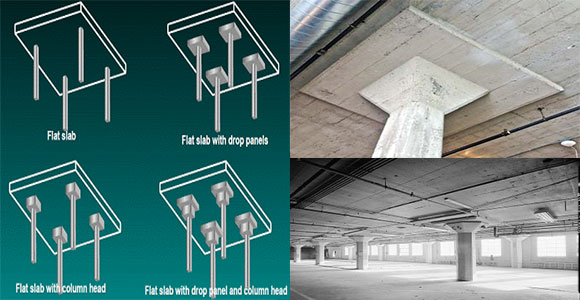A flat slab belongs to a one-way or two-way method that is condensed in the slab at the columns and load bearing walls known as ‘drop panels’. Drop panels are used as T-beams over the supports. They improve the shear capacity and the rigidity of the floor system below vertical loads, which consequently enhance the economical span range. Now-a-days, this type of construction is not recommended as the perimeter on economical spans is approximately 9.5 m for reinforced slabs and approximately 12 m for pre-stressed slabs. Reinforced flat slabs should be reasonably pre-cambered (not overdone) to manage deflection.
The primary features of a flat slab floor are a flat soffit, plain formwork and simple construction. The economical span ‘L’ of a reinforced concrete flat slab is roughly D x 28 for simply supported, D x 32 for an end span and D x 36 for an interior span. Prestressing the slab expands the economical span to D x 35, D x 40 and D x 45 correspondingly, where D denotes the depth of the slab exclusive of the drop panel.
Benefits and Drawbacks of Flat Slabs
Benefits :
• Uncomplicated formwork
• No beams—make things easier under-floor services outside the drops
• Lowest structural depth
• Generally no need of shear reinforcement at the columns.
Drawbacks:
• Moderate spans
• Usually not appropriate for supporting brittle (masonry) partitions
• Drop panels hinder in bigger mechanical ducting
• Vertical penetrations should prevent area around columns
• For reinforced flat slabs, deflection at the middle strip becomes complicated.
Ref.: civildigital.com

~~~~~~~~~~~~~~~~~~~~~
Published By
Rajib Dey
~~~~~~~~~~~~~~~~~~~~~
No comments:
Post a Comment